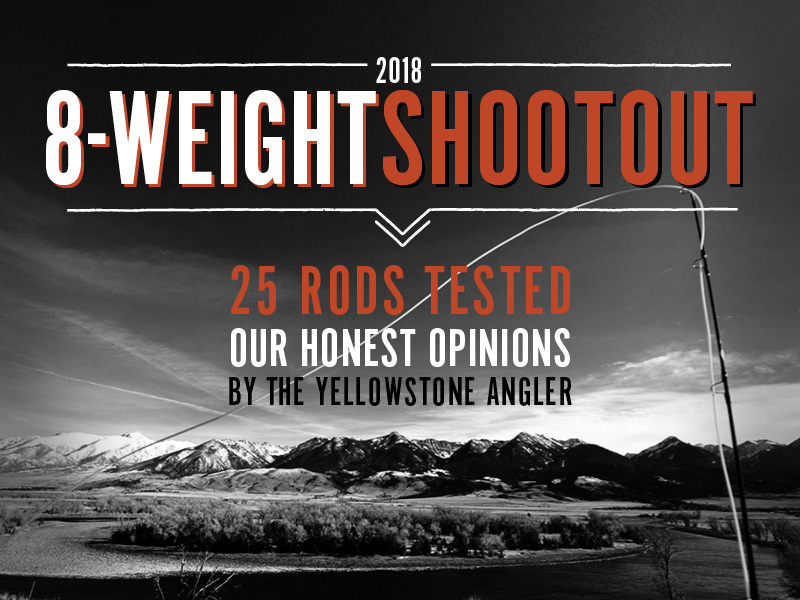
2018 8-Weight Shootout
Comments by James Anderson
In just two years, since our last 8-weight Shootout, fly rod manufacturers have developed revolutionary methods of building blanks that allow them to use less material, yet allow the rod to maintain equal or better strength. Advances in higher modulus graphite and resin systems are also giving us 8-weight fly rods have become lighter, more powerful, more accurate, more durable, and more fun to fish with. Rod manufacturers that have adapted and are not investing in the required technology to make lighter, stronger rods are quickly starting to fall behind.
As with most of our Shootouts, it was easy to identify the very best rods as well as the rods that seemed to be the worst. For rods that finished in the middle of the pack, it took more time and effort to compare them. Often it took a lot of casting and comparing to reveal the subtle differences between one rod and another. Of our four testers, we all had generally similar favorites and least favorites. Still, differences in our opinions existed, which is only normal. For every person who prefers a hoppy IPA, there is someone else who appreciates a dark porter, and yet another who prefers a pale pilsner.
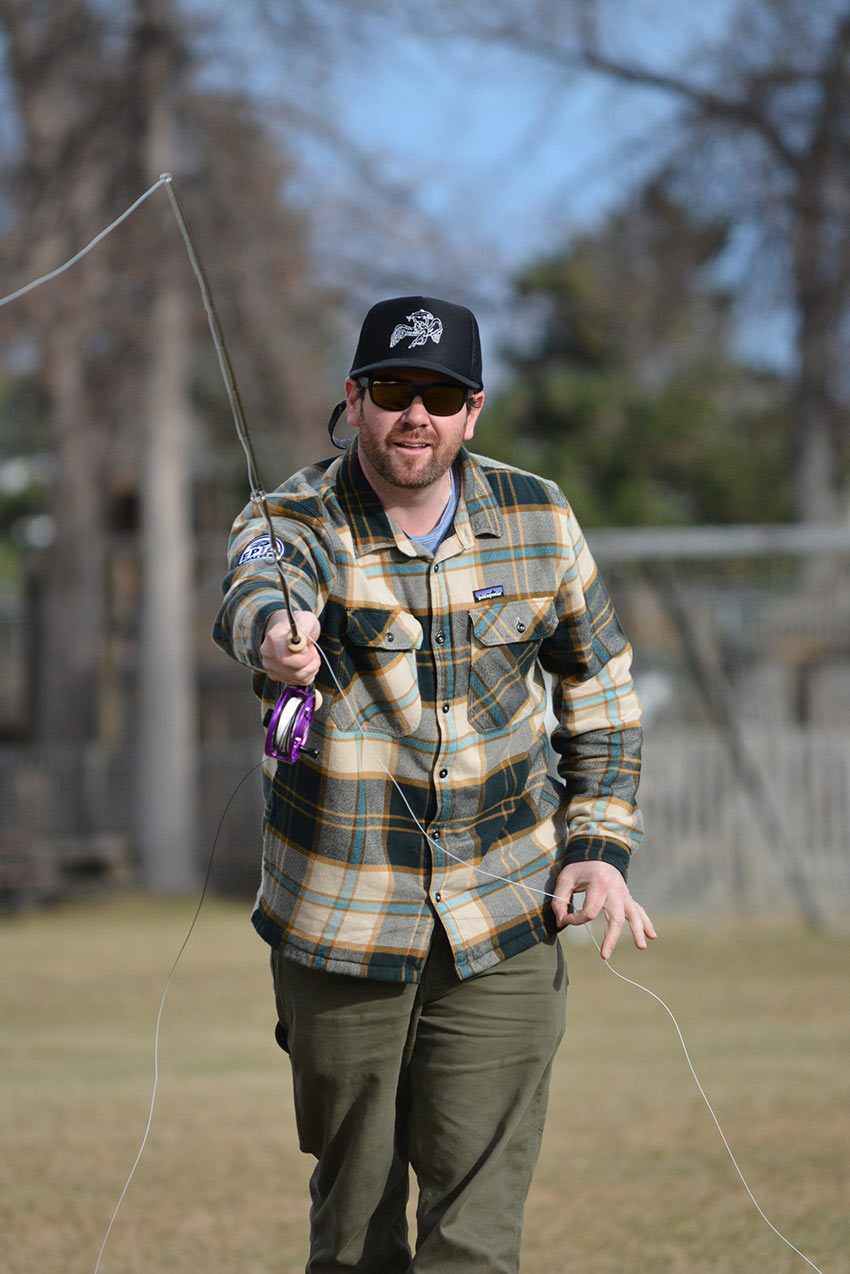
Our Shootouts are designed to help consumers narrow the wide choice of products available on the market. In the end, each angler needs to make his or her own decisions about which rods feel best, as well as how much money to spend. Although less expensive rods often do well in our Shootouts, there really is no comparison to the superior performance that most of the expensive rods provide. If you want the best performance money can buy there are no shortcuts or cheats. Don’t expect a $200-$400 rod to be equal to the best $800-$1000 rods. On the other hand you will see a few very expensive rods that did not perform well. And we’ll tell you why.
Below you will see my finishing order and notes. In general, I think everyone’s casting notes are the most helpful part of our Shootouts when deciding which rods you might like to try. Don’t get too caught up on where rods actually finished in the Final Results. How a rod performs at the various distances is much more important. We sincerely believe this Shootout will help you narrow your choice to a handful of rods that suit your style of fishing and your budget.
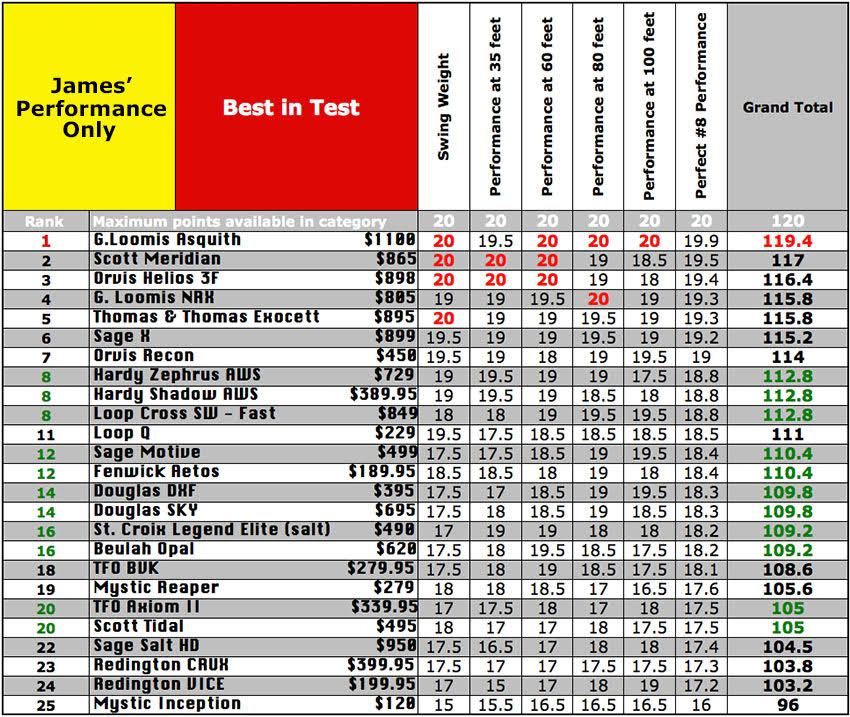
1. G.Loomis Asquith 9’#8 4pc $1100
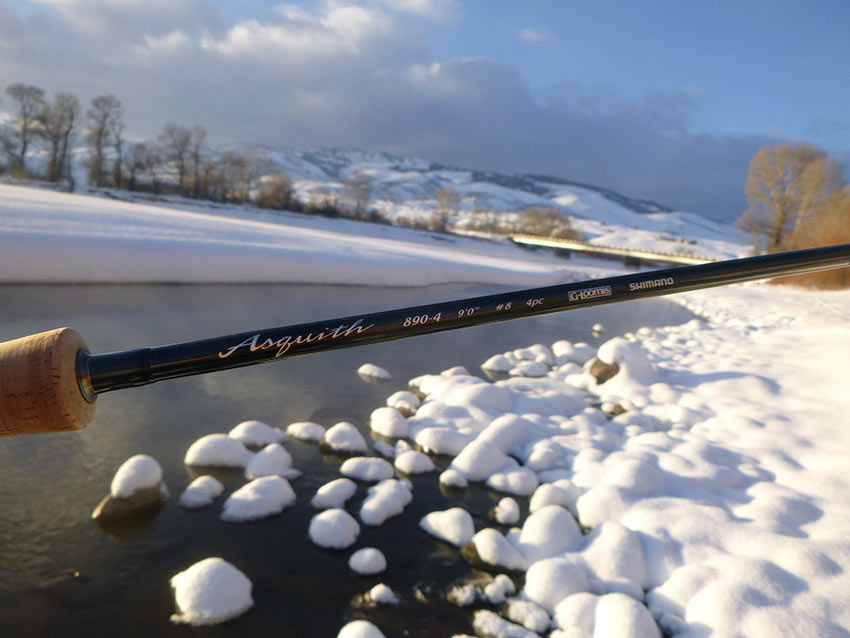

I feel like a casting champion with the G.Loomis Asquith in my hand. It casts well at all distances; it’s light, it’s accurate, it’s powerful, it’s durable, and it has a simply amazing feel to it. For almost 10 years I have owned a G.Loomis CrossCurrent GLX 8-weight and have never felt the want (or need) to replace it – until now!
The Asquith, pronounced [as-kwith] is, (in case it matters to you), named after Herbert Henry Asquith, who served as the first Earl of Oxford & Asquith, and as the Liberal Prime Minister of the UK from 1908 to 1916. The name has been the butt of more than a few jokes since the rod’s introduction last January, but perhaps Shimano’s marketing has worked, since no one seems to forget the name, or the price – and once they’ve tried it, the performance.
Of all the rods in the Shootout, the Asquith has my favorite shaped cork handle. Like the grips on the CCGLX rods, the cork handle is wider near the top but then becomes skinnier towards the bottom. Steve Rajeff developed this in the 1970’s during competition casting to help get the ring and pinky fingers closer to the palm of your hand. This allows for easier wrist rotation and casting comfort.
The Asquith blanks use 15-20% less material than what Loomis uses in the NRX, yet they are every bit as strong, if not stronger than the NRX rods. And from our own experience, the CrossCurrent GLX and NRX rods are by far the most durable rods on the market. Now that George has had the chance to put the Asquith to hard use on a variety of fish in both fresh and saltwater, with absolutely no problems, we are confident that the Asquith rods are as durable as the NRX or the CC GLX rods.
One of the things I love most about the Asquith is the huge performance window of this rod. You can choose to cast the Asquith with a relaxed stroke and it becomes absolutely effortless. But if the wind picks up and you need to accelerate your line speed, the Asquith delivers big time, with an amazing amount of reserve power.
I have never fished with a rod that had such an explosive sweet spot. When you decide to flex the Asquith in mid-stroke and apply more power, the rod responds like a high-end race ski, and rips line like no other rod I have ever cast. The sweet spot is also a little wider than the NRX, which means if your timing is off, you can still tap into the Asquith’s reserve power.
Part of the Asquith’s impressive accuracy is due to reduced ovalization of the rod as well as its clean and crisp recovery. If you are looking for a rod that can carry a lot of line in the air, yet still feels light and extremely fun to cast, look no further – the Asquith is your rod.
The only downside to the Asquith is the price, and the high repair cost. Keep in mind, other than vehicle doors, tailgates, ceiling fans, or taking a bad fall, we don’t expect it to break very easily. The spiral X, 3-layer process also takes much more time than when rolling traditional blanks, which adds to the repair costs.
Although the numbers reveal a closer finish, the Asquith easily was the most dominant rod here. I found this rod hard to put down and always a treat to go back to.
James’ casting notes:
1st impressions: Stunning in every way. Best grip in Shootout. Incredibly light. Killer sweet spot with insane, explosive reserve power. Amazingly accurate. Stronger blanks that won’t break as easily as others despite one of the lightest swing weights in the Shootout.
Performance at 35 feet: 19.5 points out of 20
Softer/faster tip than the NRX and significantly lighter. Just as accurate as the NRX, however it feels much lighter and more pleasant to cast. Still, the 3F and Meridian are just as light and deserve the edge on feel when casting in close.
Performance at 60 feet: 20 points out of 20
Wow, this rod is light! And it’s phenomenally accurate. This rod can be cast effortlessly, or you can drill it, which creates a ton of zip and zing. Another thing I liked about it over the Meridian and Helios 3F is that when the wind blew my original cast off target, the Asquith had more backbone to get back on track for an accurate second shot.
Performance at 80 feet: 20 points out of 20
The Asquith is still accurate and easily the best rod in the Shootout at this distance. The NRX was close, followed by the T&T Exocett, Sage X, and Loop Cross SW.
Performance at 100 feet: 20 points out of 20
Easily the long bomb champ for me, the Asquith felt light, powerful, and unstoppable. If you struggle with your confidence when casting longer distances, the Asquith will put you at ease.
2. Scott Meridian 9’#8 4pc $865
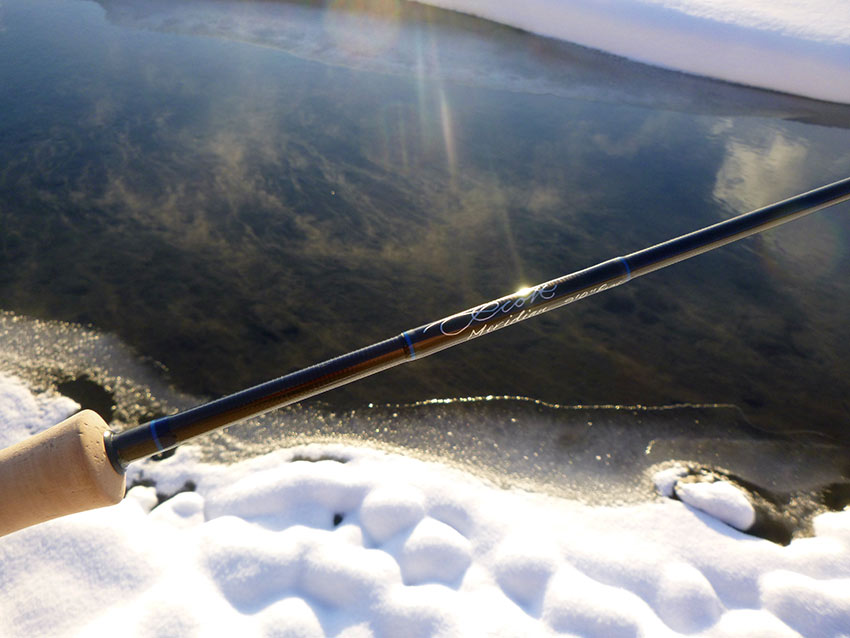

We take a lot of people out on the lawn to cast and compare 8-weight rods at the Yellowstone Angler. Although each angler has his or her own casting style and personal preferences, almost everyone loves the way the Scott Meridian performs. If I had to guess, I would say 7 out of 10 people end up choosing the Scott Meridian over all the other rods they tried. The Meridian is just one of those rods that performs well at every distance.
The Meridian has a very light swing weight, a comfortable cork grip, great power, excellent accuracy, and fabulous feel. If you look at the deflection board, it is closer in stiffness to the Orvis 3F than to the Asquith. If you are an angler that appreciates more feel over a stiffer rod, you should really give the Meridian a try, you’ll like it!
In our 2016 8-weight shootout I scored Meridian a perfect 20 at 35, 60, and 80 feet. Nothing has changed about the Meridian, however this year the Asquith had the edge at 80 and 100 feet. Despite how I score the rods at 80 and 100 feet, when we take people out on the lawn they can almost always cast the Meridian farther than anything else. And they love the feel and accuracy the Meridian gives them when casting at close range.
Aside from tremendous performance, I like the fine components Scott uses on the Meridian. The type III anodized reel seat has proven to hold up very well against salt crystals and general wear and tear. The titanium snake guides are very large and durable, but also thin and light at the same time. Not only does this help keep swing weight down, but the larger size guides allow line tangles to better escape through the rod. (If you have ever experienced hooking the biggest bonefish of your life, only to have it break off due to a line tangle, you’ll appreciate the larger guides!).
One of the things I like the most about the Meridian is how well it roll casts. It’s softer mid and tip-section are better than stiffer rods when trying to make a quick roll cast at 25-35 feet. With spooky, pressured fish becoming the norm, more guides are instructing their clients to make a quick roll cast, which creates less movement than a regular cast.
The grip is very comfortable and it forces you to choke up on the rod ever so slightly, making the rod feel even lighter in your hand. If you own more than one Meridian in different weights, having a numerical designation on the sliding band will help you quickly select your bonefish, permit, or tarpon rod. The navy and cobalt blue thread wraps look sharp on the signature unsanded blanks. The alignment dots are handy as well when putting your rod together.
When you cast and compare 8-weight rods, do yourself a favor and make sure the Meridian is one of them. There is a good chance you’ll like it the best.
James’ casting notes:
1st impressions: Classic Scott un-sanded blanks. Unique full wells grip feels very comfortable, albeit different from the rest. Very well rounded rod at all distances, Looks sharp.
Performance at 35 feet: 20 points out of 20
No doubt this rod is a winner at close range. Only the Orvis 3F felt as light and had equal feel. The Meridian seems to have a little deep load to it and flexes more in the middle where the 3F flexes more in the tip. The Meridian has excellent feel with accuracy to match. I could cast this rod all day.
Performance at 60 feet: 20 points out of 20
The Meridian produces awesome, tight, controllable loops. I’m digging it big time at 60 feet. Only the Asquith and 3F were as much fun to cast. Of the three rods, the Asquith was the stiffest and most accurate. The 3F was the softest and had the most feel. The Meridian was right in the middle. A very well rounded rod indeed.
Performance at 80 feet: 19 points out of 20
Still booming! With no wind I would be tempted to score the Meridian a perfect 20, however while the power is there, accuracy wasn’t quite as good as the Asquith or NRX.
Performance at 100 feet: 18.5 points out of 20
Here is where the Asquith takes the lead. To cast this far with the Meridian my timing had to be perfect. It was also more difficult to cast than Asquith when the wind picked up.
3. Orvis Helios 3F 9’#8 4pc $898
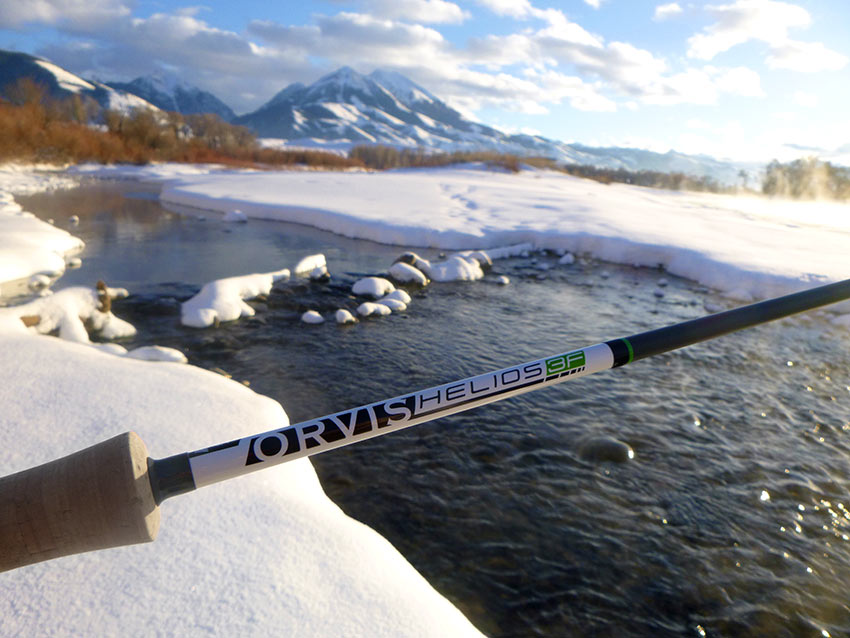

Orvis and Sage are notorious for their advertising hype when it comes to marketing their latest and greatest rod models. If you read their advertisements, or even rod reviews, (where most often the reviewer gets to keep the rod they are writing about), there’s such a ton of lingo and praise that is hard to ascertain which is truth or which is marketing hype. While I can’t speak for the other Helios 3 models yet, as far as the 9’#8 Orvis Helios 3F goes – you can believe the hype!
Trout bum, gear junkie, and most importantly talented rod designer Shawn Combs and the rest of the Orvis R&D team did a terrific job with the new H3 rods. They did their homework on this rod, and even outsourced another lab to measure and chart the oscillations from different combinations of rod tips. In the end, they went with the combinations that had the least vibration, and devloped one of the most delightful and accurate rods they’ve produced.
Although we didn’t include the stiffer H3D (D standing for distance and F standing for finesse) in the Shootout, I think it would have placed very well. In the end, we all felt that the 3F was the better of the two rods in terms of overall feel, accuracy, and casting performance at all but the longest distances. Perhaps the greatest compliment I can give the Orvis 3F is that it feels like an 8-weight version of a G.Loomis NRX-LP 5-weight. The 3F is a rod with plenty of butt section power combined with a softer/faster tip that can truly do it all.
Like the Meridian, one of the best things I like about the 3F is how well it can roll cast. The softer mid and tip-sections make it one of the better rods at roll casting 25-35 feet. As mentioned before, a roll cast is made with less movement and can help you catch otherwise easily spooked fish.
Components on the Orvis Helios 3 rods are all top of the line. The ceramic lined stripping guides help create less line friction. The large, but thin and light titanium flexible snake guides are as good as it gets. The reel seat locking rings are appropriately knurled on the outside edge but travel up and down the threads exceptionally smoothly and are as nice as any I have seen. Everything about this rod gets an A+ in my book, except for one important aspect – appearance.
People have been complaining about the aesthetics of these rods, specifically the 5.5” white section located just above the cork handle. I have not met anyone, (regardless of age), that likes the look of these rods. Many have gone so far as to mention that no matter how good the rod is they would never buy it because of its looks. I would love to own a 3F regardless of its looks, but all things being equal, it is nice to look at your rod and appreciate its appearance. No doubt, the white section certainly sets the H3 rods apart from other rods, and makes them distinctly recognizable, even from across the river.
I remember when G. Loomis introduced their bright “robin’s egg blue” thread wraps and everyone hated them. They got so many complaints in fact, that G.Loomis added a second color choice, a dark green blank with matching dark green wraps. Eventually people came around to the blue wraps, and today all the NRX rods from 7 on up use the blue wraps. I think if I were Orvis, I would come up with a second color like G. Loomis did, at least in the short run.
We did read one review that mentioned you could use the white part as a dry erase board, keeping count of your catches. Ha, ha.
James’ casting notes:
1st impressions: Good or bad, the white section above the cork really stands out. Best feel of all rods in the Shootout, especially in close quarters.
Performance at 35 feet: 20 points out of 20
At close distance, this is one sweet rod! Great feel, even as close as 25 feet. Very smooth and pleasing to cast. Even though I also scored the Meridian a perfect 20, the Orvis 3F is easily my pick for the best in close weapon of the Shootout and deserves a 21 out of 20.
Performance at 60 feet: 20 points out of 20
At mid range this 3F was awesome! Feels lighter and more effortless to cast than the G.Loomis NRX, T&T Exocett, and Sage X. Throws very tight loops and is spot on accurate, however in hard wind the Asquith gets the edge.
Performance at 80 feet: 19 points out of 20
Here is the biggest surprise of the test for me. Knowing how amazing this rod is in close and at mid distance, I was expecting it to lack the power required to throw long. I was wrong! Only the NRX and Asquith were better.
Performance at 100 feet: 18 points out of 20
Yup. No problemo!
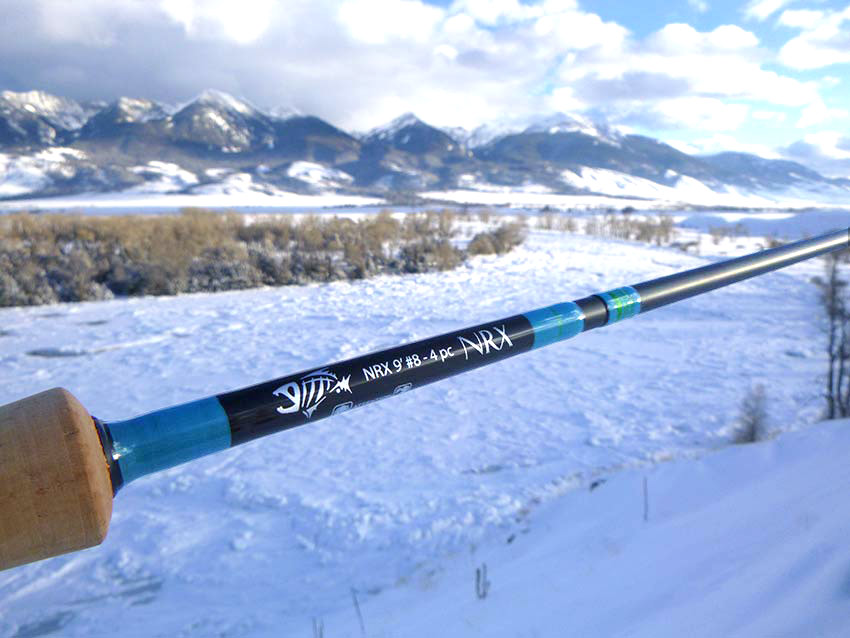

The G.Loomis NRX has been one of those “timeless rods” that continues to perform at a high level. Some designs just work well and as the old saying goes, “if it ain’t broke don’t fix it.” Luckily, the NRX rods (and CrossCurrent GLX rods) are still in G.Loomis’ line up and are still selling strong.
One thing that really impresses me about the NRX is how accurate it is. Every manufacturer brags about the accuracy of their rods, but the NRX truly does feel like one of the most accurate rods on the market. An accurate cast is probably the most important factor in fishing success, especially when it comes to huge, smart, pressured bonefish.
The NRX has never really felt heavy to me until this year. I used to think the Scott Meridian was just an anomaly when it won our 2016 8-weight Shootout. Now, when compared to the Asquith, Meridian, 3F, and Exocett, the NRX does feel noticeably heavier in hand. Even rods like the Sage X, Orvis Recon, and Loop Q had lighter swing weight.
The good news is we know how strong the G.Loomis NRX and CCGLX rods are. No other rods have been put through more abuse and have survived time and time again. Whether they were tested down at Jurassic Lake on fat 20-pound rainbows, or bent to the cork on strong steelhead, these rods have proven themselves to be the toughest and most durable we have found. In talking with the guide and outfitter community, we don’t find much argument here either.
James’ casting notes:
1st impressions: Bright “robin’s egg” blue wraps set it apart from other rods. One of the most accurate rods in the Shootout. One of the strongest rods in terms of breakage.
Performance at 35 feet: 19 points out of 20
Pleasant, and really accurate, but the Asquith has an even nicer, softer tip. Hit the plate every single time, with the line landing soft enough. Tempting to give a 20 due to amazing accuracy but less feel compared to the Meridian and 3F gets it a solid 19.
Performance at 60 feet: 19.5 points out of 20
“Nothing wrong with that!”
Lots of power matched with excellent accuracy. Would have been a perfect 20 but the Asquith, Meridian, and 3F feel lighter in hand and get the edge.
Performance at 80 feet: 20 points out of 20
The NRX throws long like a champ. As good at long range as the Asquith, and definitely better than the Meridian or Helios 3F at the 80 foot mark.
Performance at 100 feet: 19 points out of 20
Seeing how easy it was to cast 80 feet, I expected the NRX to be on par with the Asquith, but it’s not nearly as powerful or light at 100 feet.
5. Thomas & Thomas Exocett 9’#8 4pc $895
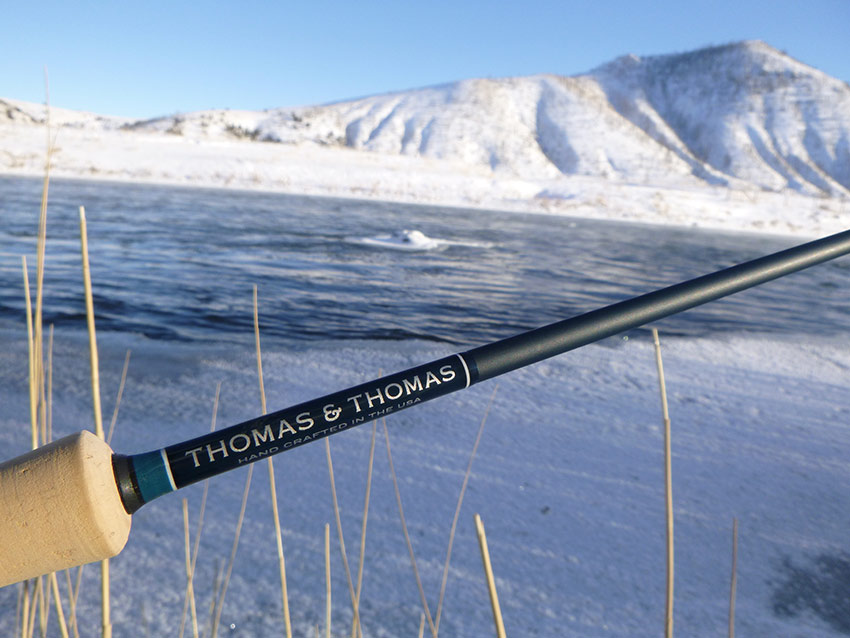

T&T may have shown up late to the party, but they have arrived in style and are turning heads. We are pleased to report that T&T’s new Exocett has a much lighter swing weight than previous models. Function as well as fashion have now become a viable reality for Thomas and Thomas. I’m sure those manufacturers that have a larger market share in the industry are taking notice.
T&T has always been right at the top when it comes to immaculate craftsmanship and the use of the best components. In past Shootouts, the only thing holding them back was heavier swing weights than we saw on the best performing rods. But today they are producing some of the lightest and most delightful rods to cast in the world. Give credit where credit is due, and our hats go off to Thomas and Thomas.
Looking back at my performance scores, I’m a little surprised that I didn’t give the Exocett any perfect 20 scores. Digging deeper into this matter, I suppose the reason for this is that the competition was just so good. When casting rods head to head the slightest edge in feel is often very subtle, (and subjective). In the end, I went with my gut on which rods were the most accurate and had the very best feel, even though I’m now lacking the words to explain exactly why they felt a touch better. I think if T&T gave us a slightly softer tip on the Exocett, it would be on the podium, if not right on top.
James’ casting notes:
1st impressions: Nice grip, beautiful rod, exceptionally craftsmanship, definitely has a stiffer feel to it.
Performance at 35 feet: 19 points out of 20
This rod is amazingly accurate. But I’m not getting as much feel out of the rod as the Asquith, Meridian, or 3F. It feels pretty similar to the NRX, with spot on accuracy.
Performance at 60 feet: 19 points out of 20
Again accuracy is impressive, but the Asquith, Meridian, and 3F are equally accurate with better feel. This rod can handle a serious punch, and its tracking ability limited tailing loops.
Performance at 80 feet: 19.5 points out of 20
Tempted to give this rod a perfect 20 but the Asquith has a little more spring in its step. A stellar long distance performance. Clearly one of the stronger / stiffer rods in the Shootout. It is amazing they can build a rod so light yet so powerful.
Performance at 100 feet: 19 points out of 20
I thought the Exocett would be better at 100 feet. It was very good, but the Asquith, Orvis Recon, Loop Cross SW, Sage Motive, and Douglas DXF were better throwing the long bomb.
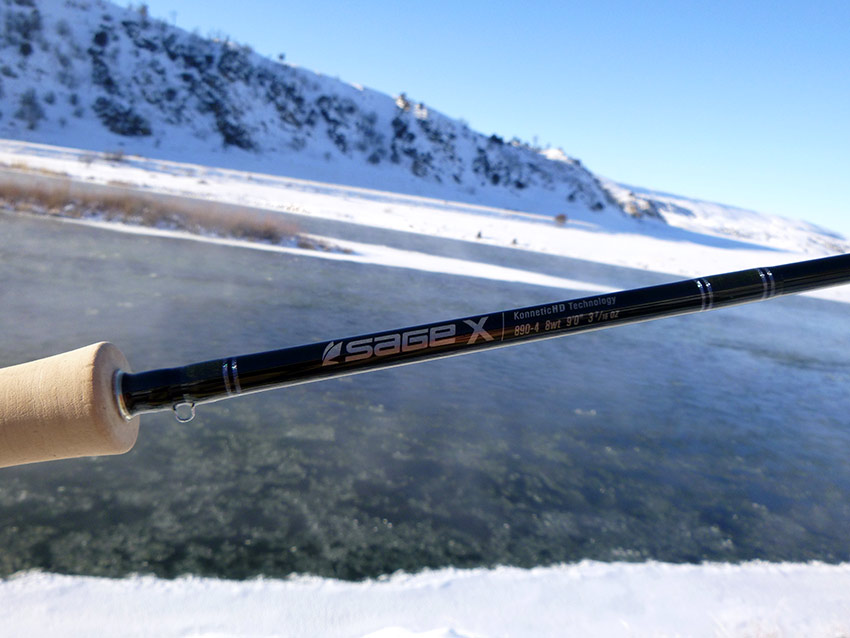

I’ll start by saying this is easily the best Sage 9 foot 8-weight I have ever cast. What changed? The X is lighter in swing weight with a faster/softer tip than previous models, making it a much better all-around rod as opposed to just a great rod at the longer distances.
Not only does the X have one of the lighter swing weights, it is also one of the three lightest rods in overall weight. This makes it especially pleasing when you pick it up off the rod rack and give it a “wiggle test.” Likewise, it is very agreeable while casting at all distances. Big props go out to Jerry Siem, Sage’s head rod designer with the X, specifically the 790, 890, and 990 models. Aside from the 389LL, 590 Z-Axis, and a handful of excellent switch and spey rods, the 9’ 8-weight X has become one of my favorite Sage rods.
This was the kind of performance I was hoping for when we first tested the X in our 6-weight shootout. I think if Sage shaved off a little material in the tip and made it slightly softer/faster it would have received perfect scores at 35 and 60 feet. It was however, fantastic at 80 feet, with only the Asquith and NRX better for me. The X is a great choice for both fresh and saltwater, although I’d like to see slightly larger guides for use in saltwater. If you are a diehard Sage fan, get this rod while you can – it is going to be one of the Sage’s GOAT rods.
James’ casting notes:
1st impressions: “Man the X feels light!” This rod feels great in my hand. Guide wrap epoxy coatings look much better now than they have in the past.
Performance at 35 feet: 19 points out of 20
Very accurate and light in swing weight, however not nearly enough feel for a perfect score in close. Still, this is perhaps Sage’s best attempt yet at an 8-weight rod that performs well at all distances and not just at long range.
Performance at 60 feet: 19 points out of 20
Now I’m starting to get more feel out of the tip. This rod feels MUCH lighter and easier to cast than the Sage Salt HD. In the end the Asquith, Meridan, Helios 3F, and NRX felt like they had a little more “pep” to them.
Performance at 80 feet: 19.5 points out of 20
Easily the best Sage rod in the shootout, the X is light yet very powerful. It has the power required to carry a lot of line in the air, albeit it is no Method or TCX.
Performance at 100 feet: 19 points out of 20
As they say in the The Big Labowski, “Does the Pope $#%^ in the woods?” Fantastic long range performance. Only the Asquith, Recon, Loop Cross SW, Motive, and DXF were better.
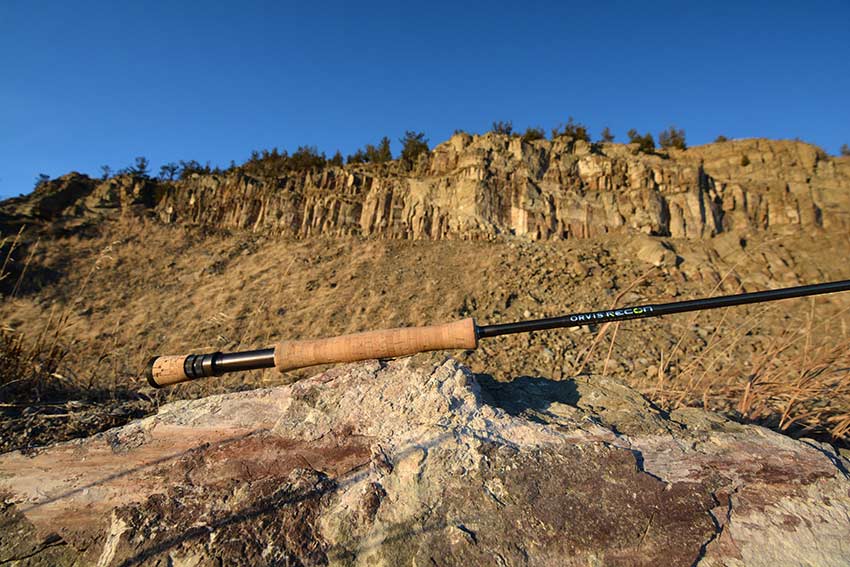

Looking back at the 2016 8-weight shootout, the Orvis Recon tied for 4th place. It has been selling strong and performing well ever since. Orvis did a great job with the Recon, giving us a great performing rod at half the price of their premium Helios 3 rods. By building good rods in a variety of price ranges, Orvis has created a large following of loyal customers.
The Orvis Recon really does look and feel like an expensive rod. From the cloth bag, to the hard case, to the components and craftsmanship, this rod is dressed to impress. It is also one of the lightest rods in our Shootout. No, it doesn’t match the quality or components found on the Helios 3 rods, but it doesn’t disappoint when you take it out for a spin on the water either. Looks, performance, and a reasonable price – everything about the Recon makes it a smart buy. The Recon is our choice for the best mid-price rod in the Shootout. You can buy even better, but you can’t go wrong with a Recon.
James’ casting notes:
1st impressions: High-end look and performance for a middle of the road price.
Performance at 35 feet: 19 points out of 20
Excellent accuracy and control although not as much feel as the best rods. The Recon feels nice and light too, – not much to complain about here!
Performance at 60 feet: 18 points out of 20
Impressive power when you lay into it, however it was not as effortless to cast as the top rods. I found my best accuracy came when casting this rod aggressively.
Performance at 80 feet: 19 points out of 20
Excellent power, coupled with feel. To cast 80 feet you’ll want to be aggressive and the Recon is up to the task.
Performance at 100 feet: 19.5 points out of 20
One of the better rods in the Shootout for throwing long, you’ll easily be able to reconnoiter the edge of the bonefish flats with this rod.
8. (tie) Hardy Zephrus AWS 9’#8 4pc $729
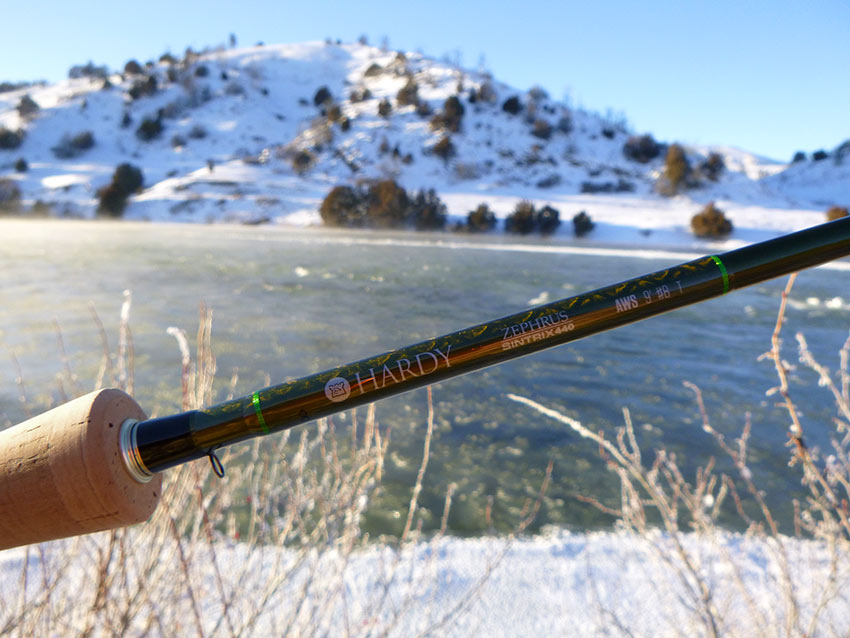

This year we tested the Hardy Zephrus AWS rather than the Zephrus SWS. The “All Water Series” version was just as pleasing as the “Salt Water Series,” however, given a choice between the two, if I were doing a lot of salt-water fishing I would go with the SWS version, which has larger guides.
The Zephrus is a good-looking rod, finished in an attractive green. If I had to describe the Hardy Zephrus AWS in one word it would be smoooooth. Smooth and light, the Zephrus was one of the best casting rods at the shorter distances, where it also delivered excellent feel and accuracy. Like the Meridian and the Helios 3F, the Zephrus is one of the best rods at 35 feet. But don’t let this in close killer fool you, it still has the power required to throw 80 feet and beyond.
James’ casting notes:
1st impressions: Green colored blank jumps off the rack more so than others. Interesting but attractive reel seat, with a green graphite insert that matches the color of the blank. Tracks well and has great feel.
Performance at 35 feet: 19.5 points out of 20
Tons of feel combined with great accuracy. This rod was right on the fence for getting a perfect score here, however the Meridian and Helios 3F had a touch more feel. Even at 35 feet I can tell this rod tracks very well.
Performance at 60 feet: 19 points out of 20
Smooth as butter and tracks as straight as an arrow. I’m hitting near or on the target every cast. I like this rod a lot more than the old Hardy ProAxis, which was a heavy clunker in comparison.
Performance at 80 feet: 19 points out of 20
Can still hold a tight loop with a good 70 feet of line in the air. I find myself wanting to shoot a little line to get it the extra 10 feet, and this diminished the accuracy a bit compared to the best rods.
Performance at 100 feet: 17.5 points out of 20
Now I’m starting to struggle to hit 100 feet. More overall power would help here. My timing had to be absolutely perfect or the result was a tailing loop. The Zephrus isn’t one of the best long bomb rods.
8. (tie) Hardy Shadow AWS 9’#8 4pc $389.95
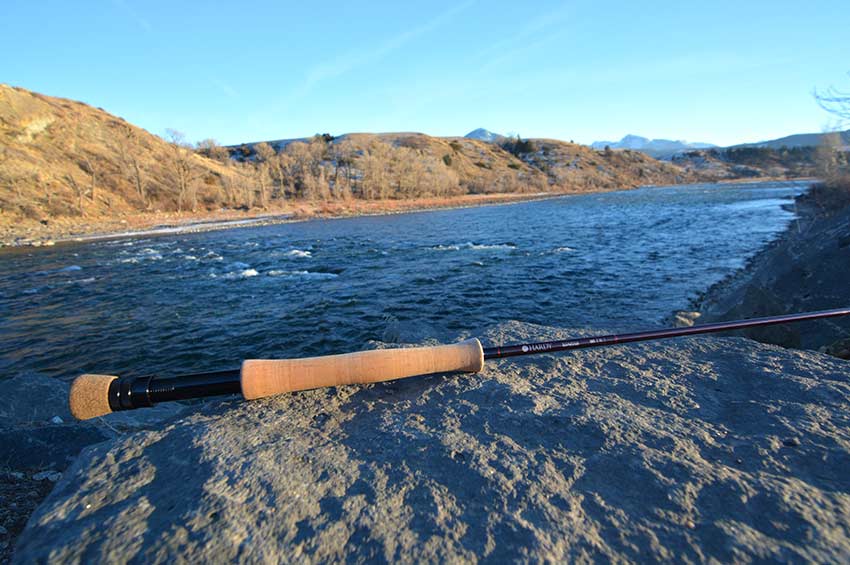

The Hardy Shadow was one of the bigger surprises of the Shootout. The Shadow is not new to Hardy, but the Shadow AWS, constructed with their new SINTRIX® 220 nano resin is.
Like the Zephrus, everyone loved the smoothness of the Shadow. Although it was better in close than at long distance, the Shadow had enough beans to get it done at 80 feet. I especially like the price when you consider the performance you are getting.
I do wish this rod had larger guides. Like the Hardy Wraith, the small single-foot guides present a problem when it comes to line tangles. If you fish this rod for bonefish, eventually you are going to get burned by these guides. When you do, hopefully it is not the biggest bonefish you have ever hooked, although that’s usually how Murphy’s Law works. Hardy should consider building a Shadow SWS with larger guides. If they did, they would have a great mid-priced bonefish rod locked down at $60 less than the Orvis Recon.
I’m looking forward to casting this rod in the 5, 6, and 7-weight models. I suspect they will give Douglas a run for the money when it comes to the best mid-priced freshwater rods.
James’ casting notes:
1st impressions: The gorgeous dark ruby color helps it stand out from the other 8-weights. This rod has a thin grip, and the single-foot guides are tiny for an 8-weight. Excellent feel for a rod under $400.
Performance at 35 feet: 19.5 points out of 20
Excellent feel with very good accuracy. Although it is not as light as the top rods, it feels light enough, especially for the money. Feels like a poor man’s Orvis Helios 3F.
Performance at 60 feet: 19 points out of 20
Very smooth, even delightful. I really wish this rod had larger “saltwater” guides, but as is it’s a killer streamer rod here on the Yellowstone.
Performance at 80 feet: 18.5 points out of 20
Easy enough to get the distance, but I’m not nearly as accurate as with other rods. Still, not a bad performer, especially considering the price.
Performance at 100 feet: 18 points out of 20
No problem! Surprisingly I could hit 100 feet more easily than with the Zephrus.
8. (tie) Loop Cross SW – Fast 9’#8 4pc $849
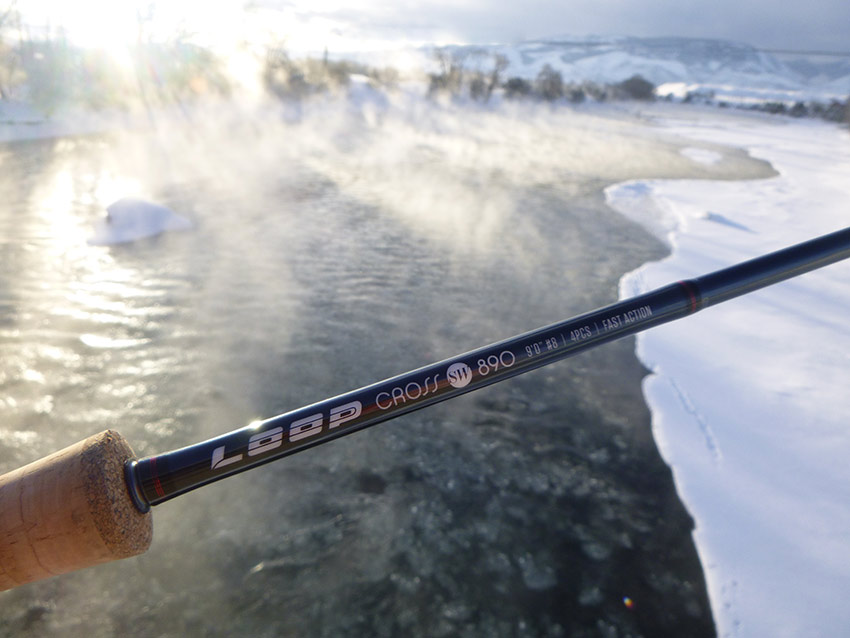

I love everything about the Loop Cross SW except for its slightly heavier swing weight. It is smooth, powerful, and accurate. This is probably not the best choice if you are looking for an all-around rod, but it is a terrific choice if you are looking primarily for a saltwater 8-weight that casts well in the wind and handles the longer distances with ease. A true powerhouse, this rod will not disappoint anyone who needs to rely on a rod that will deliver 60-100 foot casts consistently and with good accuracy.
I like what Loop has done with full wells grip on the Cross SW. It feels very comfortable. The large guides may be overkill, but they do give you a good chance to survive a line tangle.
James’ casting notes:
1st impressions: Interesting grip with a comfortable swell in the middle of the cork. Not the lightest rod. Big beefy guides.
Performance at 35 feet: 18 points out of 20
A lot heavier feel than the Asquith, and not nearly as accurate. Short distance is not this rod’s forte.
Performance at 60 feet: 19 points out of 20
Smooth, strong power but the heavier swing weight is noticeable. Once you do get the rod in motion there is a ton of power behind it, which seemed to help when casting in a strong wind.
Performance at 80 feet: 19.5 points out of 20
Prepare to launch because this rod is a cannon! I would have scored it a perfect 20 but the Asquith has the same kind of freight train power yet feels much lighter.
Performance at 100 feet: 19.5 points out of 20
Mega power, but this rod requires a lot more effort than the Asquith to get it going. It reminds me a of heavier drift boat that takes several strokes to get going, but then coasts once you get it in motion.
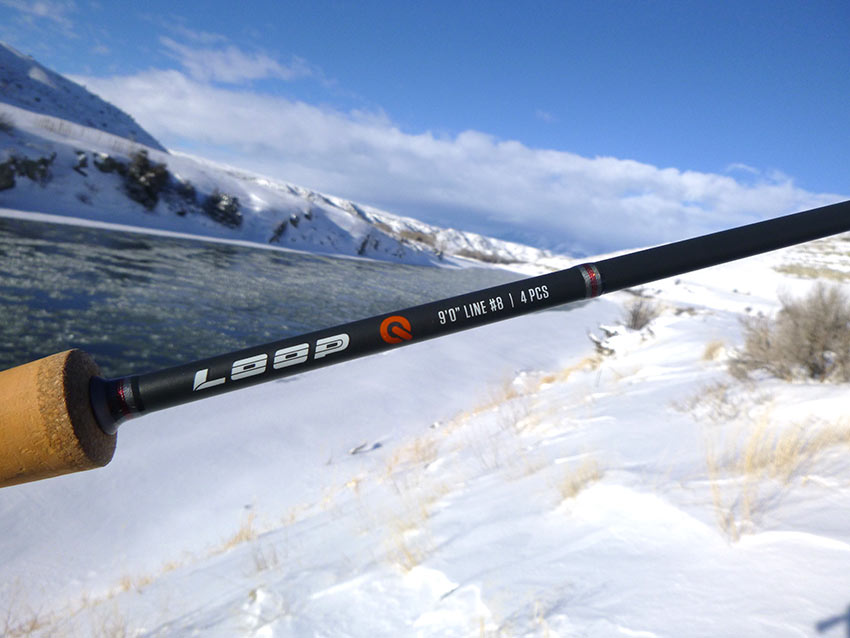

The Loop Q was another pleasant surprise in our Shootout. The Fenwick Aetos (at $189.95) now faces some real competition when it comes to the best inexpensive 8-weight. I was really impressed with how this rod performed at 6o and 80 feet, especially considering the price. If Loop gave us a nicer cork grip, I could see the Loop Q being competitive at the $350-450 price mark.
Look out TFO, Redington, Mystic, and Fenwick – there is a new player in town!
James’ casting notes:
1st impressions: The quality of cork feels cheap compared to other cork handles. Otherwise, amazing performance for the money.
Performance at 35 feet: 17.5 points out of 20
The rod feels light and the fast action feels just right! But I’m not getting the same accuracy and feel I got with the top rods.
Performance at 60 feet: 18.5 points out of 20
With a nice blend of power and feel, at 60 feet the Loop Q feels more and more like an expensive rod. I was tempted to give this rod a 19+ score but the other rods were still a tad more accurate.
Performance at 80 feet: 18.5 points out of 20
The Q is much softer than the Loop Cross SW, so you’ll want to take your time and slow down your casting stroke. Punching it hard doesn’t work well. Just take it easy and let the rod do the work for you.
Performance at 100 feet: 18.5 points out of 20
Difficult, but doable. As long as you have your timing right this rod won’t buckle, but if you punch it too quickly, expect tailing loops.
12. (tie) Sage Motive 9’#8 4pc $499
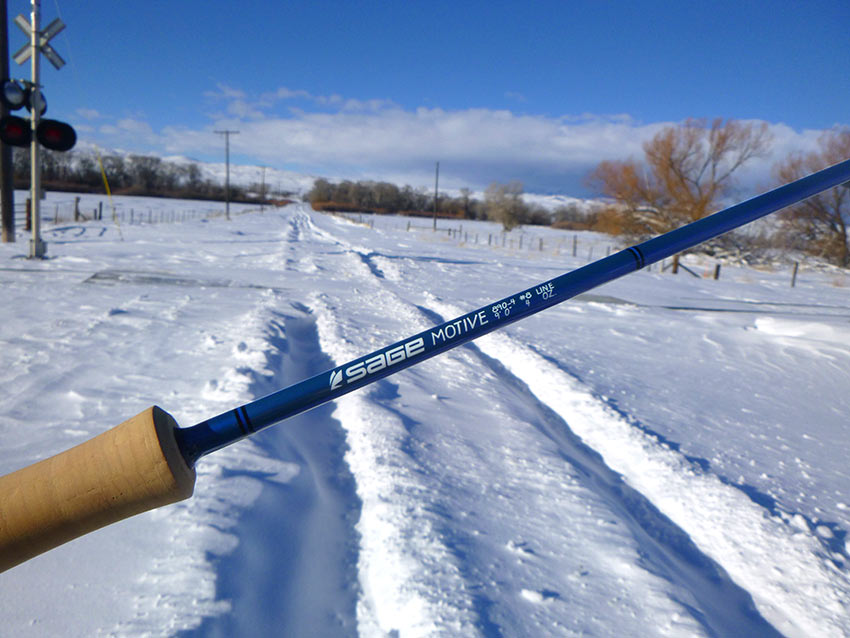

The Sage Motive is a great casting rod. Very smooth and accurate, it is a solid performer at all distances, especially when you consider the price. The only thing holding it back from a higher finish was its heavier overall and swing weights. I thought the Motive in our 2016 Shootout felt lighter, but in checking the exact weights, the overall weight is the same. The swing weight was lighter, but not much- 11.4 oz. to 11.2 oz. this year. Make no mistake though; the Motive is a heavy rod – Far heavier than the X.
In the last 8-weight Shootout we liked the Motive a lot better than the Sage Salt. This year the honor of Sage’s best 8-weight easily goes to the X. Of course, saving $400 and putting that towards a good saltwater reel and line does have its appeal…
James’ casting notes:
1st impressions: Last year’s Motive felt lighter? Cool blue candy paint color makes it very photogenic.
Performance at 35 feet: 17.5 points out of 20
Deadly accurate, I hit the plate nearly every time, but my delivery was too aggressive to get the leader and fly to land softly.
Performance at 60 feet: 18.5 points out of 20
The Motive gave me very smooth loops and good accuracy. I love everything about this rod but the heavier swing weight.
Performance at 80 feet: 19 points out of 20
When casting at longer distances the heavier swing weight is less of an issue. This rod is fun to cast long, as it has enough power to carry the whole 80 feet of line in the air. Since there is no need to shoot line it was also very accurate.
Performance at 100 feet: 19.5 points out of 20
Kaboom! This rod is powerful, and one of my favorites for throwing long. I’m not getting the same tight loops as I did with the Asquith however.
12. (tie) Fenwick Aetos 9’#8 4pc $189
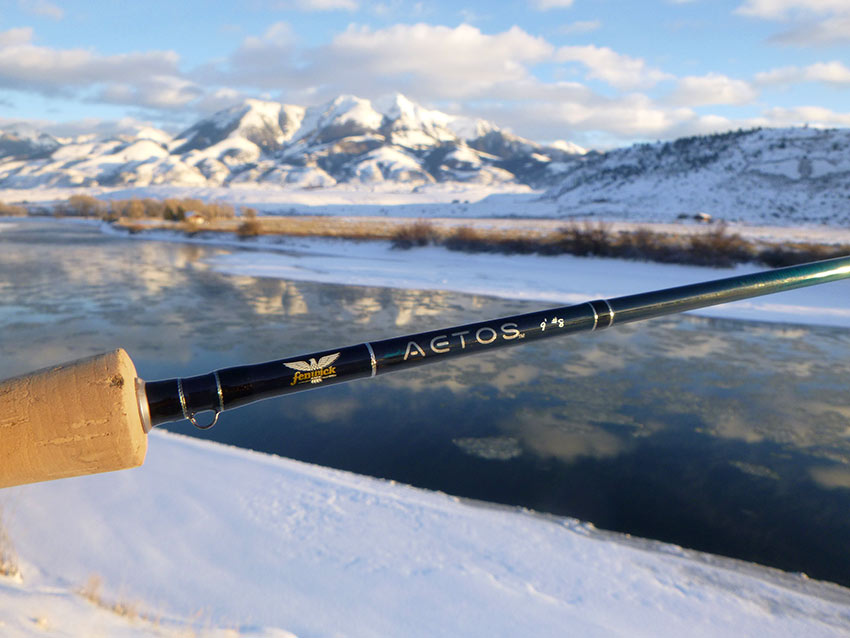

Plain and simple – the Fenwick Aetos offers the best performance you can get for the least expensive price. Only the Loop Q, (for $40 more) comes close. The Aetos is a good-looking rod with decent components, and one of the best warranties we’ve found. Here is our choice for the best inexpensive 8-weight in the Shootout.
The Aetos is no stranger to us for superior performance at an inexpensive price. The 9 foot 5 and 6-weight rods have always performed well in our past shootouts, as has the 11’1” 5-weight switch rod. If you want good performance combined with a good price, look no further.
James’ casting notes:
1st impressions: Excellent performance value.
Performance at 35 feet: 18.5 points out of 20
Surprisingly good! The Aetos feels good in hand, with pretty good feel and accuracy. Thumbs up, especially for the money.
Performance at 60 feet: 18 points out of 20
Plenty of power! I was not quite as accurate with it as with other rods, however. I got the best accuracy with the Aetos when I was casting it aggressively, much like the Recon.
Performance at 80 feet: 19 points out of 20
For me, as nice as the Recon at 80 feet. If your maximum budget is under $200, the Aetos is the winner.
Performance at 100 feet: 18 points out of 20
Here’s where the Recon and the Motive are worth the extra dough. Both do a better job at extreme long range and for handling heavy wind.
14. (tie) Douglas DXF 9’#8 4pc $395
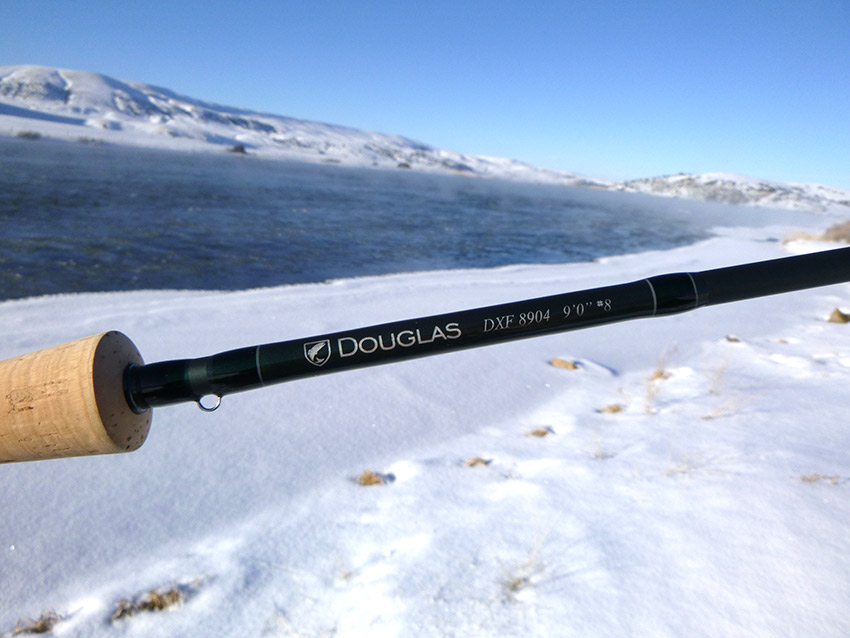

The DXF has always been one of our favorite mid-priced 9’ 5 and 6-weight rods. But I think the 9’ 8-weight needs a little whittling. The DXF 8-weight has great power, but this comes at the price of heavy swing weight. To be a great all-around rod I think the tip needs to become a little softer/faster, and the swing weight needs to be lighter. I’m confident that Douglas’ head rod designer Fred Contaoi will tweak the DXF into perfection. He is a great angler and one of the hardest working rod designers out there. Douglas has impressed us before by making running changes in the 9’ 6-weight and 7-weight SKY models. My crystal ball says Fred won’t sleep until the DXF is a contender for the best mid-priced rod.
All that being said, remember this rod only costs $395, and it beats many rods costing much more. There is still great value in the DXF, especially if you are looking for a less expensive rod that works extremely well on windy days, with the ability to cast long distances.
James’ casting notes:
1st impressions: Massive guides. Grip is a little on the thick side. Feels more like the Douglas SKY this year.
Performance at 35 feet: 17 points out of 20
This rod is very accurate but I found it difficult to make a softer presentation. It is noticeably tip heavy and doesn’t have much feel while casting in close quarters.
Performance at 60 feet: 18.5 points out of 20
Excellent accuracy, however the DXF feels stiff and heavy in the tip compared to the top rods. But no question – it is a powerhouse. If you are looking for an 8-weight that is closer to a 9-weight this would be a good choice.
Performance at 80 feet: 19 points out of 20
Wow. I was pleasantly surprised by the DXF at 80 feet and beyond. Now the heavier swing weight is less of an issue and the DXF feels like it has some serious pep.
Performance at 100 feet: 19.5 points out of 20
Hmm… this might be my second favorite rod for the long bomb award, just behind the Asquith. With little threat of throwing a tailing loop, you can really punch it hard with this rod.
14. (tie) Douglas SKY 9’#8 4pc $695
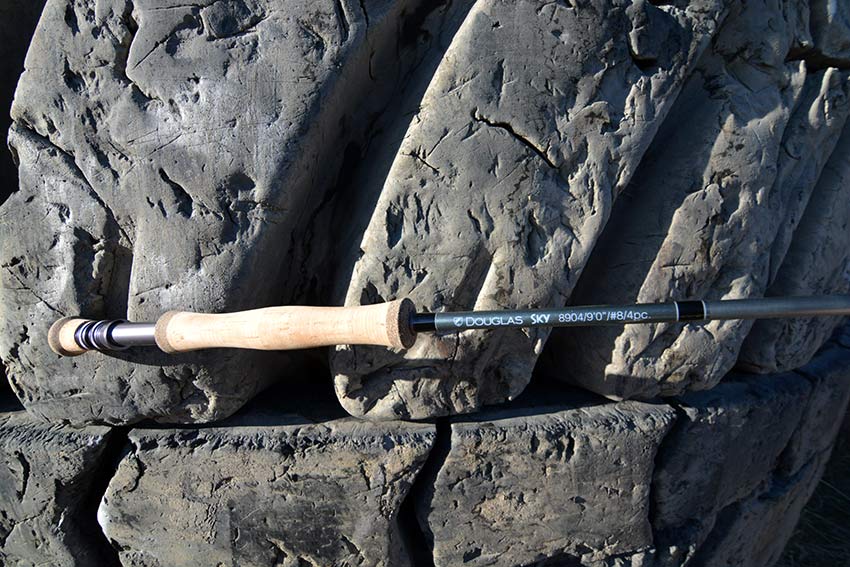

After seeing the 9’ 6-weight Douglas SKY sweep the competition in our 2016 6-weight Shootout, (and knowing how much George loves the 9’ 7-weight version) we were all expecting a podium finish for the 8-weight SKY. Unfortunately, it was just a little too heavy and stiff in the tip to take top honors this go around.
When head rod designer Fred Contaoi heard where the SKY placed in this 8-weight Shootout he was disappointed but determined more than ever to tweak the SKY into a true winner. When lastly heard, he was on his way to South Korea, to work with the factory to develop prototypes for an improved 8-weight SKY. We are looking forward to the results. Nevertheless, the current SKY really didn’t do that badly, especially when casting longer distances.
James’ casting notes:
1st impressions: Interesting angle on Fuji Torzite shooting guides. Nice grip, similar to Meridian and Loop Cross SW.
Performance at 35 feet: 18 points out of 20
Very accurate, however, the SKY feels stiffer and heavier than the top rods when casting in close.
Performance at 60 feet: 18.5 points out of 20
Now we’re talking! Plenty of extra power – I think the sweet spot for this rod may even be past 60 feet, (70-75 feet). Like the Loop Cross SW, the SKY takes a little more effort to get going but then there is nothing stopping it.
Performance at 80 feet: 19 points out of 20
This rod has a ton of balls. I was hitting near the plate almost every cast. Tempting to give the SKY a 19.5-20 score, but the best rods were just lighter in hand and a little more effortless to cast.
Performance at 100 feet: 18.5 points out of 20
Strangely enough I could hit the 100’ mark better with the DXF. Still, a solid performer. With a little tweaking (making the tip lighter and faster) I expect the SKY to perform better at all distances.
16. (tie) St. Croix Legend Elite Saltwater 9’#8 4pc $490
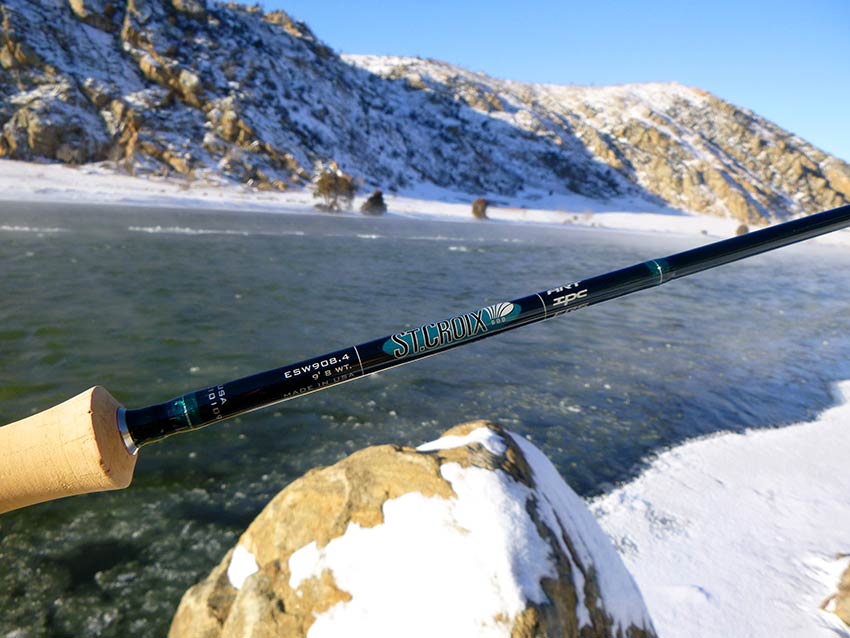

The St. Croix Legend Elite Saltwater rod has always been a solid performer. In our last 8-weight Shootout I had the St. Croix Legend Elite ESW tied for third place. It is still the same fantastic rod, however in the past few years other manufacturers have been pushing the limits in terms of lighter rods that are equally powerful and durable. It may finally be time for St. Croix to change things up a bit and come out with a new, lighter saltwater rod.
Aside from having a heavier swing weight, the Legend Elite is a very smooth casting rod. It is also a very accurate rod with impeccable line tracking. The St. Croix Legend Elite ESW is a great choice if your budget is $500 or less and you want a rod made in the USA. There is not much to complain about here.
James’ casting notes:
1st impressions: One of my favorite actions. Great all-around rod for the money. Excellent craftsmanship. Could be lighter.
Performance at 35 feet: 19 points out of 20
Very nice, smooth feel, also very accurate. Not as light or as much feel as the Asquith, Meridian, 3F, or Zephrus, however.
Performance at 60 feet: 19 points out of 20
This rod tracks exceptionally well! It feels very smooth, but heavier in hand than the top rods. Lots of usable power once you get it going…
Performance at 80 feet: 18 points out of 20
I notice the heavier weight now, and it lacks the pep of the Asquith, NRX, Exocett, X, and Loop Cross SW.
Performance at 100 feet: 18 points out of 20
It was difficult to cast the full 100 feet. Other rods like the Asquith and Exocett had more explosive power at extreme long range.
16. (tie) Beulah Opal 9’#8 4pc $620
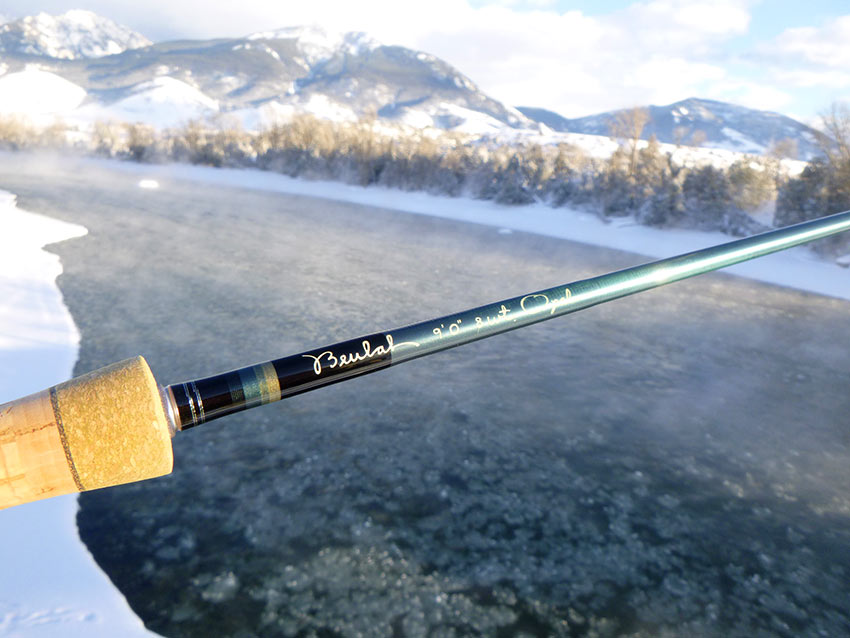

Beulah has always impressed us with sharp-looking rods, and the Opal is no exception. I love the blue and gray-toned thread wraps over the blue blank. The different colored cork accents also make this rod look classy.
Performance-wise, the Beulah Opal does best around 60 feet. At this distance everything feels right. To give it more feel in close, I think the Opal’s tip needs to be a little softer. To perform better at 80-100 feet the Opal needs a little more butt and mid-section power. All and all, still a great rod at a reasonable price.
James’ casting notes:
1st impressions: Sharp looking rod. Comfortable grip. Smooth casting but lacks power at long range.
Performance at 35 feet: 18 points out of 20
Feels very smooth and fun to cast, however the slower tip isn’t allowing me to be very accurate.
Performance at 60 feet: 19.5 points out of 20
At mid-range, the Opal feels very well balanced, with smooth power and excellent accuracy. I’d say 60 feet is definitely this rod’s sweet spot.
Performance at 80 feet: 18.5 points out of 20
Another fine performance at 80 feet. Accuracy was not quite as good as the top rods but satisfactory nevertheless. Not bad!
Performance at 100 feet: 17.5 points out of 20
Doable, but you have to shoot a lot of line, as the Opal doesn’t want to carry much line in the air. Getting the Opal to cast 100 feet is tough.
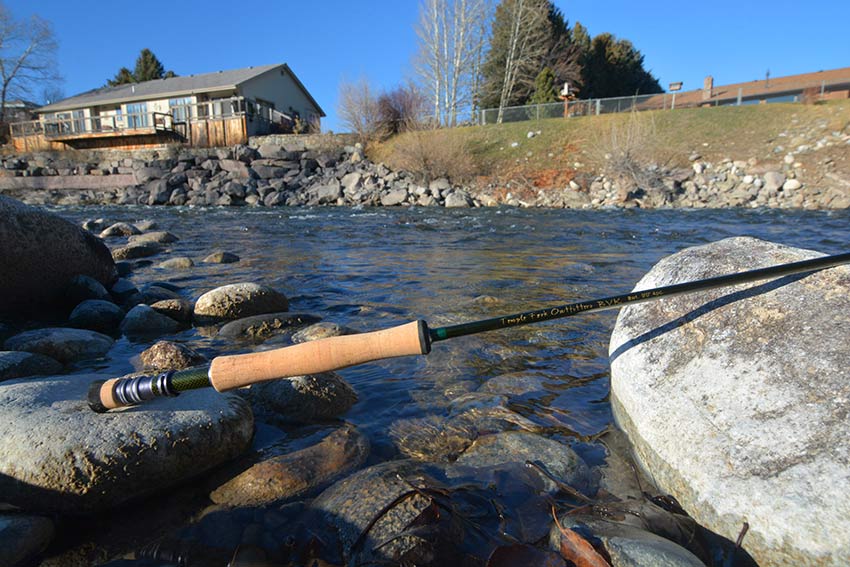

With TFO’s introduction of their new Axiom II rod, we wondered if the BVK would get pushed to the side. Although it was close, I think the BVK is still TFO’s best performing saltwater 8-weight rod.
The BVK has plenty of power, but was also fairly heavy in swing weight, despite its very light overall weight.
James’ casting notes:
1st impressions: Impressive power and performance for the money.
Performance at 35 feet: 18 points out of 20
Feels slightly lighter and softer than the DXF at close range. Definitely heavier and less feel than the best rods, but not disappointing either.
Performance at 60 feet: 19 points out of 20
Nothing to complain about here! Tons of power with a smooth flex in the tip. Feels similar to an NRX, just a little heavier.
Performance at 80 feet: 18.5 points out of 20
Here the edge goes to the DXF, which is saying a lot since we’ve always liked the BVK’s performance throwing long. Nearly tailing loop-proof, the BVK is a rod you can really punch. I just wish it were lighter.
Performance at 100 feet: 17.5 points out of 20
Now that I said tailing loop proof, I started throwing a few when I was pushing this rod hard trying to hit 100 feet. Every rod has a limit and this is it for the BVK.
19. Mystic Reaper 9’#8 4pc $279
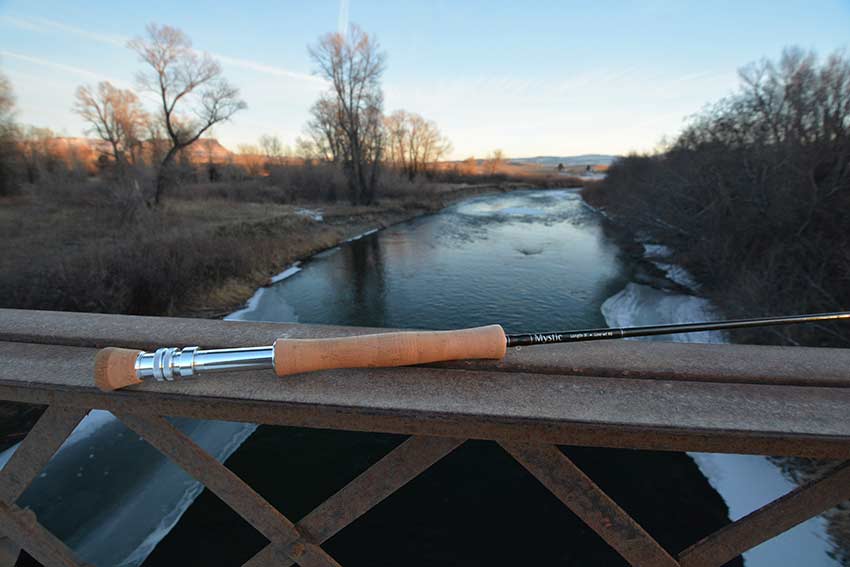

The Mystic Reaper is a good rod for casting in close quarters. Its softer mid and tip-sections do well when roll casting or when trying to cast delicately in close.
The Reaper is not a great choice for an all-around 8-weight however, as it is simply too soft in the butt and mid sections. When I was casting at the longer distances it was hard to come up with the power I needed to make the casts. If your timing isn’t perfect, expect to see a tailing loop or tangle.
James’ casting notes:
1st impressions: Massive swell and size in the cork handle. The action feels just too soft for an 8-weight. Shiny silver reel seat stands out amongst the others.
Performance at 35 feet: 18 points out of 20
The Reaper is much lighter in the hand than the Mystic Inception, with better feel and accuracy as well.
Performance at 60 feet: 18.5 points out of 20
Aside from the huge grip, this rod feels very good when casting at 60 feet. It has a smooth transfer of power with decent accuracy. Very nice.
Performance at 80 feet: 17 points out of 20
The Reaper doesn’t have a lot of power or backbone, so I had to shoot a lot of line to hit 80 feet. The Reaper has a long way to go to keep up with the Aetos and BVK at long distance.
Performance at 100 feet: 16.5 points out of 20
My timing had to be perfect, otherwise I got tailing loops and had a lot of difficulty hitting 100 feet. If you need an inexpensive rod that will handle the wind or extreme distances the Redington Vice and TFO BVK are better rods.
20. (tie) TFO Axiom II 9’#8 4pc $339.95
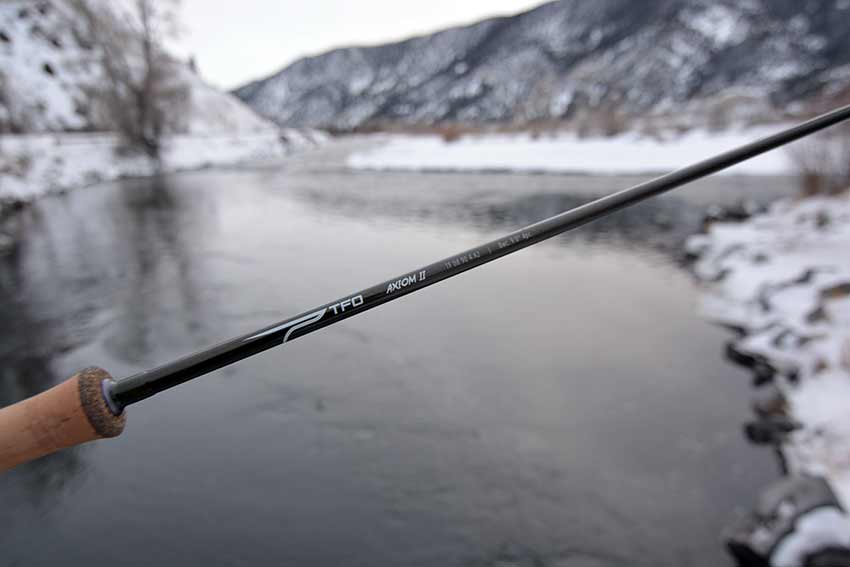

TFO’s new Axiom II rod is pretty good, but I still think the BVK is a better rod with better feel and equal power. One thing the TFO Axiom offers over other rods is a much thinner grip, which could be more comfortable (and easier) for anglers with smaller hands to get a more powerful grip. Like the BVK the Axiom is very light in overall weight but has a much heavier swing weight.
At least TFO gives you a hard case with the Axiom II, unlike the BVK.
James’ casting notes:
1st impressions: Thinner but comfortable grip that might be nice for anglers with smaller hands. BVK still seems like the better all-around 8-weight.
Performance at 35 feet: 17.5 points out of 20
Fairly accurate, but very little feedback or feel. Pleasant enough, but the edge in close goes to the Fenwick Aetos, Hardy Shadow, Mystic Reaper, and TFO BVK.
Performance at 60 feet: 18 points out of 20
Feeling much better, with more line in the air. Feels slightly heavier than the BVK in terms of swing weight. The BVK also gave me better performance at mid-range. The skinny grip feels a little odd.
Performance at 80 feet: 17 points out of 20
A solid performance, but I still liked the feel and power of the BVK better.
Performance at 100 feet: 18 points out of 20
Ha, now I’m confused as it feels the Axiom II seems to throw better than the BVK when you really have to punch it! But neither came close to matching the DXF at extreme long range.
20. (tie) Scott Tidal 9’#8 4pc $495
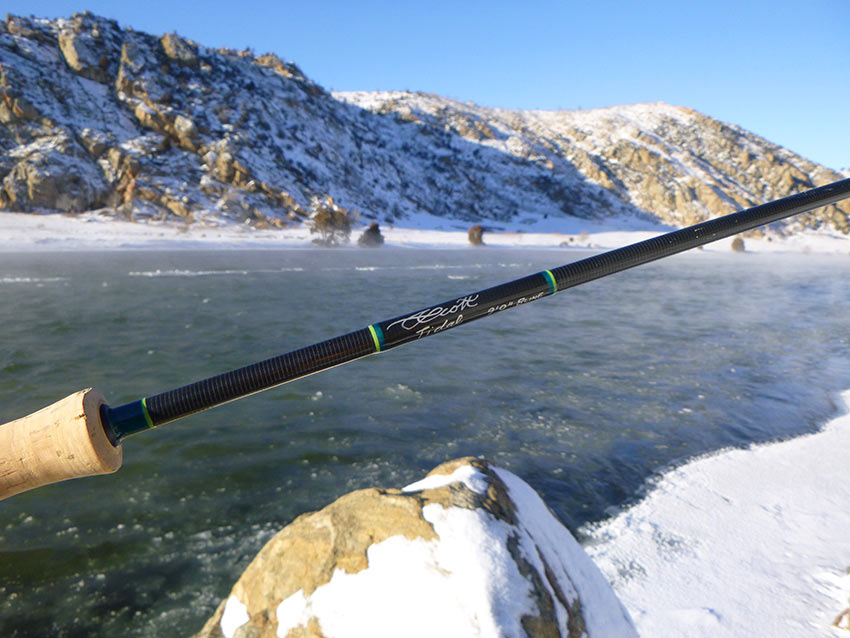

I had high hopes for the Scott Tidal, mostly because the Meridian 8-weight is one of the best rods in the world, and I expected the Tidal to follow suit. The Tidal does use Scott’s traditional graphite gray unsanded blank that allows you to see the tape wraps. I liked the teal colored wraps with green trim that give this rod some pop. The Tidal however, has a significantly heavier swing weight and is slower in action than the Meridian.
Knowing Scott’s capabilities, I hope they will produce a new sub $500 rod in the near future that will blow the Tidal away. While a lot of anglers appreciate a slower action for trout fishing, a slower/heavier rod doesn’t have many advantages for saltwater fishing.
James’ casting notes:
1st impressions: Classic Scott unsanded blanks, Looks like a high-end rod. Comfortable full wells grip, although I preferred the grip on the Meridian. Both heavier and slower in action than the Meridian.
Performance at 35 feet: 17 points out of 20
Tip heavy and stiff, this was not my favorite rod to cast in close. It reminds me a bit of the Sage Salt HD or old Hardy ProAxis with a less stiff butt section and slower/stiffer tip.
Performance at 60 feet: 17 points out of 20
Not that accurate, and not that much fun to cast. Tip heavy. For me the Meridian is SOOOO much better.
Performance at 80 feet: 18 points out of 20
Takes more effort to get the Tidal going but I’ll have to admit, it does have decent power. I was getting tighter loops with other rods like the DXF, and accuracy was more or less left up to luck.
Performance at 100 feet: 17.5 points out of 20
I thought this rod might perform better for me at 100 feet over 80 feet but it didn’t. I found my timing had to be perfect to hit this distance.
22. Sage Salt HD 9’#8 4pc $950
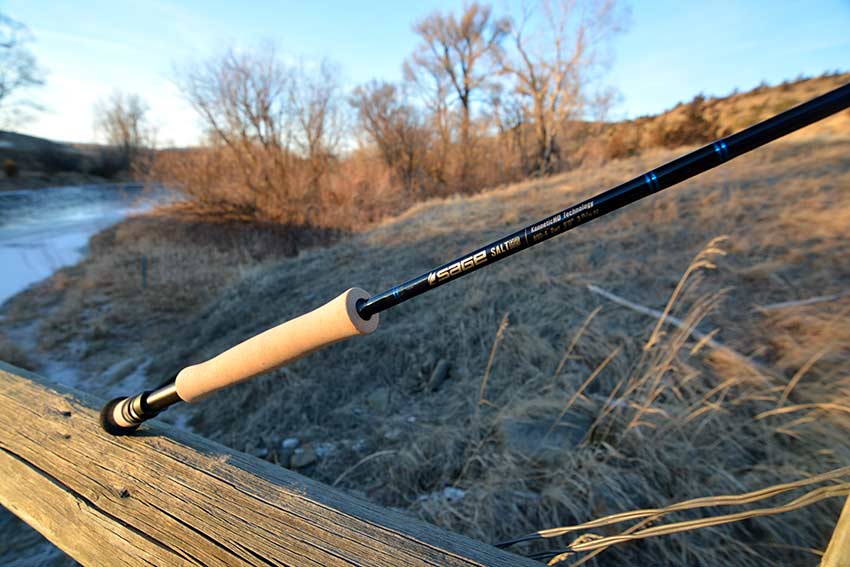

You’ll read a lot of hype about the new Salt HD fly rods. All I can say is that this is definitely a rod that I recommend you try before you buy. And when you try it, be sure to cast it against the Sage X and a couple of the other top rods in our shootout. I think you’ll find the Salt HD is much heavier and less accurate than Sage’s other rods or all the top dozen rods in our Shootout. The important thing, as always, is to find a rod that works well for you.
The HD did not work well for me. Its heavy swing weight and slower action than the X made this rod disagreeable to cast at close to mid-range. It was much more difficult to dial in accuracy with the Salt HD than with the Asquith, Meridian, and Helios 3F. Those other rods felt effortless to cast compared to the Salt HD. I felt like I was constantly fighting the HD’s heavier/stiffer tip, and my accuracy and enthusiasm suffered.
There are a few things I do like about the Sage Salt HD. First is its stylish paint job. The squid ink blank and blue highlight wraps make this rod look cool. I also like the reel seat on this rod better than what we found on the X. The locking rings worked well, and feel a little beefier and easier to grip than the ones on the X. Last but not least, the larger hard chrome snake guides seem more saltwater appropriate than the guides on the X, but they are also heavy and this contributed to the Salt HD’s heavy swing weight.
I wish Sage used the same large size but thin titanium snake guides like those found on the Asquith, Meridian, 3F, NRX, Exocett, and Cross SW. These lighter guides would dramatically reduce the swing weight. If they are going to charge $950, the least they can do is provide the best components available on the market. This year’s epoxy coatings over the thread wraps look better than what we have seen in the past.
James’ casting notes:
1st impressions: Nice reel seat. Nice paint job – this rod looks sharp. Feels tip heavy with stiff/slow tip and a softer butt section. Lackluster performance for a rod approaching the $1000 mark.
Performance at 35 feet: 16.5 points out of 20
Very tip heavy and not pleasant to cast in close. Accuracy was mediocre at best. I wasn’t able make a delicate presentation with the HD; it was more of a plate slapper than the top rods.
Performance at 60 feet: 17 points out of 20
Again, the tip feels too stiff and I didn’t have the control or feel I was looking for. And the accuracy suffered accordingly. I had my best luck with this rod once I stopped trying to control the rod and just let it do its thing.
Performance at 80 feet: 18 points out of 20
The Salt HD felt best to me at 80 feet. It took a lot of effort and energy on my part to get the rod going compared to other rods, but I have to admit, once it was in motion it did a good job of finishing longer casts. I don’t see many people throwing tailing loops with this rod either, which is a good thing.
Performance at 100 feet: 18 points out of 20
The HD will hit the 100-foot mark with practice, concentration and a lot of effort. I just think the lighter rods with stiffer butt sections felt a lot better here. Sage rods like the Motive and X both felt better to me at 80-100 feet.
23. Redington CRUX 9’#8 4pc $399.95
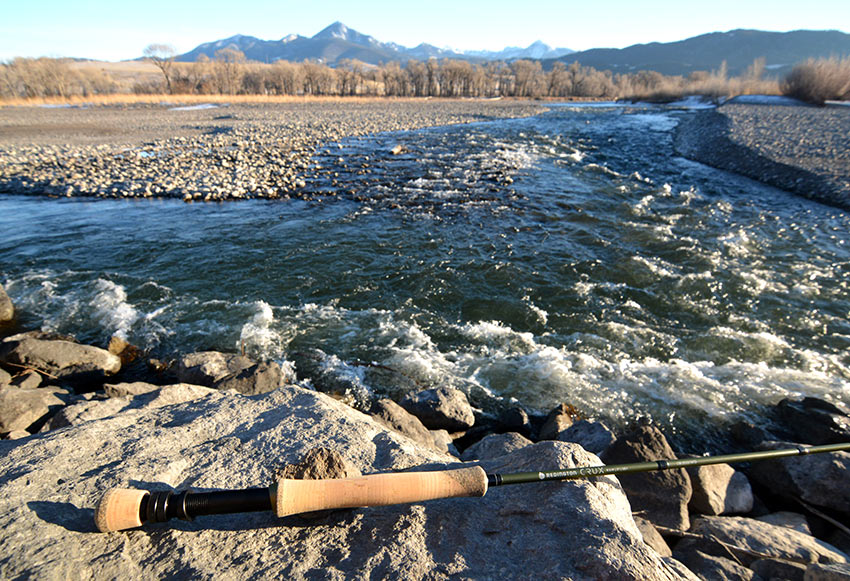

We have seen better rods from Redington before, (the CPX comes to mind), despite Redington’s claim of the CRUX being the best rod they’ve ever made. While it is better than the VICE, I’m not sure if it is $200 better. Given their cost, I’d choose the VICE instead and put the extra $200 towards a nicer saltwater reel and line.
Redington’s introduction of their Angled Key Grip (a denser pre-compressed cork material near the top of the cork) may increase durability but I doubt it will reduce much hand fatigue from wielding this heavy wand all day. Compared to the X, the CRUX feels much stiffer with little life to it.
James’ casting notes:
1st impressions: Interesting “Sci-fi” font on rod and reel seat. Unique cork at the top, different looking lock rings on reel seat.
Performance at 35 feet: 17 points out of 20
Lighter than the VICE but nearly as stiff. Not too much fun casting this rod in close as it had very little feel.
Performance at 60 feet: 17 points out of 20
Again it feels and performs a lot like the VICE – not so good. The CRUX is powerful and can be punched or you can take it easy with it. I just wish it were not so heavy.
Performance at 80 feet: 17.5 points out of 20
Powerful indeed, but you pay the price in a heavy swing weight. Getting the distance is no problem, but I’m not getting the same fun feedback or accuracy that other rods gave me.
Performance at 100 feet: 17.5 points out of 20
Doable, but the edge goes to the VICE for sure.
24. Redington VICE 9’#8 4pc $199.95
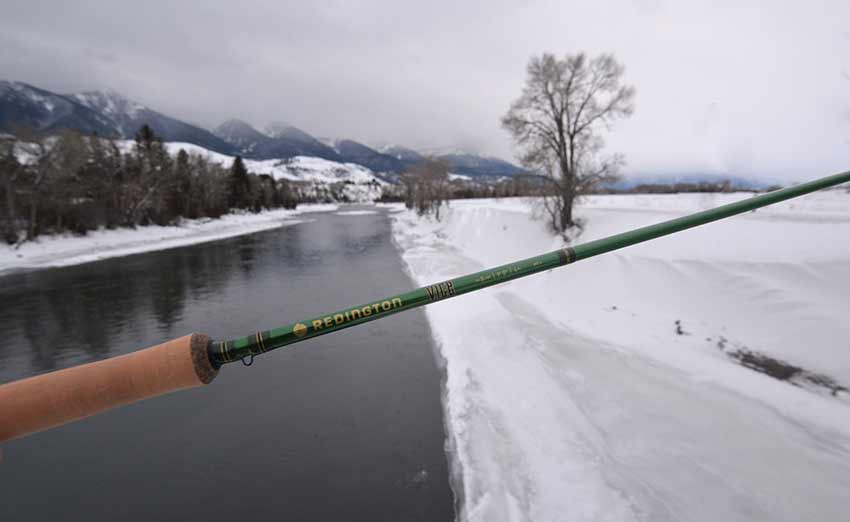

The Redington VICE is one of the best inexpensive rods for fishing in extremely windy conditions or when trying to throw 100 feet on every cast. Other than that, it is simply too heavy and stiff to perform at all well at the short to medium distances. Feels like an even heavier Salt HD, but with a stiffer butt section. Over-lining this rod with a 9 weight line would be the way to go to improve its short to mid-range performance.
At the $200 price level, it just cannot compete with other great all-around rods like the Fenwick Aetos and Loop Q.
Unless you already own another rod that performs much better in close and at mid-distances, I would steer clear of the VICE. Fishing this rod hard all day will likely lead to other vices – namely whisky and aspirin.
James’ casting notes:
1st impressions: Strange Vampire/Grand Theft Auto “VICE” font on rod blank. The thinner grip feels good although it looks a little odd to me.
Performance at 35 feet: 15 points out of 20
Very heavy and almost no feel. The worst performance in our Shootout in close.
Performance at 60 feet: 17 points out of 20
Again, too heavy and stiff to feel as pleasant as the lighter, more energetic rods.
Performance at 80 feet: 18 points out of 20
I had to score the VICE a little higher at 80 feet. When casting and punching this rod, the heavy weight was less noticeable. Not much chance of throwing tailing loops with this rod.
Performance at 100 feet: 19 points out of 20
Wow. I’m impressed. 100 feet is very easy with this rod. It is probably the best inexpensive rod in the Shootout for fishing in heavy winds or throwing extreme distances.
25. Mystic Inception 9’#8 4pc $120
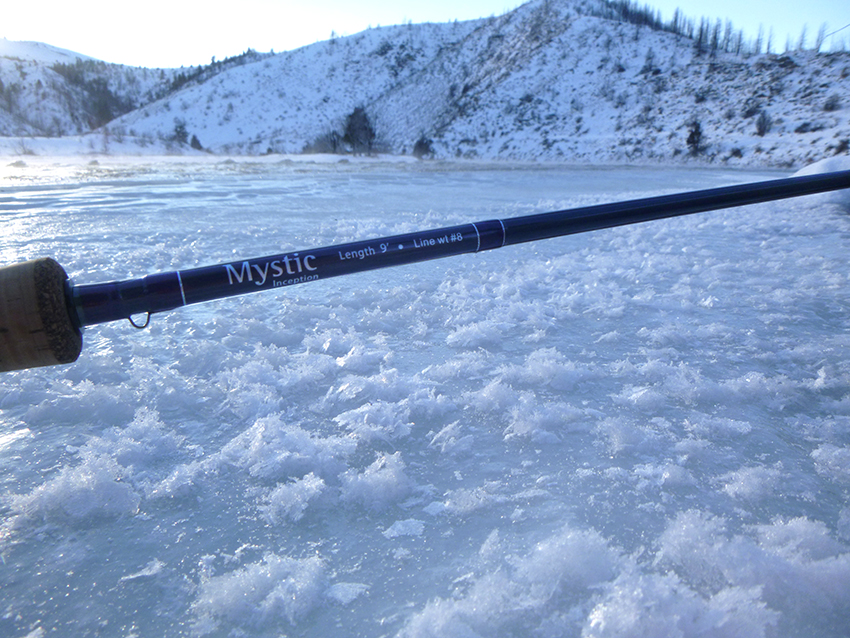

In hindsight, we probably should not have included the Mystic Inception in the Shootout. We wanted to have a rod in the Shootout that retailed for around $100, since Echo did not want to participate, (despite the fact that the Echo Base would have out-performed many rods in the Shootout at only $99.95).
We thought the Inception might fill that void but it doesn’t. It is simply too heavy, too slow, and too clunky to compete with the better inexpensive rods. It does look attractive. In the end, if it gets you out fishing then there is really not much to complain about…
James’ casting notes:
1st impressions: Looks good, attractive blue color. Massive cork grip. Too heavy, slow, and stiff. Like the TFO BVK, no hard case is included.
Performance at 35 feet: 15.5 points out of 20
Brutally tip heavy and slow in action. Almost no feel or accuracy. Not much fun to cast in close when compared to the other inexpensive rods like the Aetos.
Performance at 60 feet: 16.5 points out of 20
Heavy and clunky, the Mystic Reaper would be a much better choice.
Performance at 80 feet: 16.5 points out of 20
Distance was not a problem, but accuracy was out the window. I had to open my loop and aim higher to get this rod to hit 80 feet. The extra weight is making double hauling more of a chore, and is taking all the fun out of it.
Performance at 100 feet: 16.5 points out of 20
I think I was getting 100 feet about 1 out of 10 casts with the Inception. The heavy weight was killing me, and I think I’m ready to incept a drink or two.
Thoughts About a Purchase
If you are thinking about buying a fly rod, we suggest reading one of our Shootouts for the line size rod you want. You’ll find these on our Yellowstone Angler website home page. If your local shop stocks the rods you are interested in, by all means visit them, try a few rods and purchase an outfit from them.
If you cannot find or cast the rods that interest you, we are here to help. Call us at 406-222-7130, and we will discuss your needs and wants. If you happen to be looking for an 8-weight, we hope that this Shootout has been informative. With our combined input, I’m confident that we can come up with the perfect rod or outfit that best fits your needs. Normally if you are getting both the rod and reel, we’ll throw in an $85 line for free, and also ship it to you for free as well. And since we are in Montana, there is no sales tax.
When you get the rod, do some casting on the lawn, and if you feel it is not just what you want, and it has not been fished and looks 100% new, we’ll allow you to return it to us for a full refund, less the shipping charges.
These Shootouts take a lot of time and effort, so if you like what we are doing the best way to thank us is to buy a rod, reel, or outfit from the Yellowstone Angler. Use this link to go to our Favorite Fly Rod Outfits. Here you’ll find our recommendations in three price ranges: Best Buy, Mid-Priced, and the Ultimate Outfit.
If you get to Montana, we invite you to stop at our shop and do your own mini-Shootout right on our lawn. We have several reels rigged up with the various line sizes, and leaders, all ready to go. We’ll come out with you and give you some help to fine tune your casting stroke, or just help you with the basics. And once you’ve picked out the perfect rod, stay and enjoy a few days on the water with one of our top guides.
We value your comments about the shootout and invite any questions you might have about it or your tackle needs. We have fished all over the world in both fresh and saltwater for a variety of fish, and we’ll be glad to help answer any questions you might have.
– George, James, and the rest of the Yellowstone Angler crew
